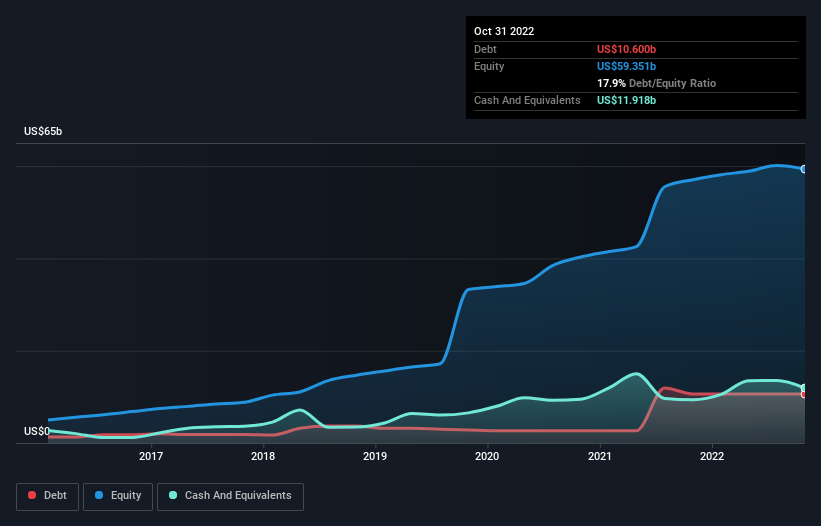
Howard Marks put it nicely when he said that, rather than worrying about share price volatility, ‘The possibility of permanent loss is the risk I worry about… and every practical investor I know worries about.’ It’s only natural to consider a company’s balance sheet when you examine how risky it is, since debt is often involved when a business collapses. Importantly, Salesforce, Inc. (NYSE:CRM) does carry debt. But should shareholders be worried about its use of debt?
When Is Debt A Problem?
Debt assists a business until the business has trouble paying it off, either with new capital or with free cash flow. Ultimately, if the company can’t fulfill its legal obligations to repay debt, shareholders could walk away with nothing. However, a more common (but still painful) scenario is that it has to raise new equity capital at a low price, thus permanently diluting shareholders. Of course, debt can be an important tool in businesses, particularly capital heavy businesses. When we examine debt levels, we first consider both cash and debt levels, together.
See our latest analysis for Salesforce
What Is Salesforce’s Debt?
The chart below, which you can click on for greater detail, shows that Salesforce had US$10.6b in debt in October 2022; about the same as the year before. However, it does have US$11.9b in cash offsetting this, leading to net cash of US$1.32b.

A Look At Salesforce’s Liabilities
According to the last reported balance sheet, Salesforce had liabilities of US$18.2b due within 12 months, and liabilities of US$14.3b due beyond 12 months. Offsetting this, it had US$11.9b in cash and US$4.28b in receivables that were due within 12 months. So it has liabilities totalling US$16.3b more than its cash and near-term receivables, combined.
Since publicly traded Salesforce shares are worth a very impressive total of US$139.2b, it seems unlikely that this level of liabilities would be a major threat. However, we do think it is worth keeping an eye on its balance sheet strength, as it may change over time. Despite its noteworthy liabilities, Salesforce boasts net cash, so it’s fair to say it does not have a heavy debt load!
Shareholders should be aware that Salesforce’s EBIT was down 49% last year. If that decline continues then paying off debt will be harder than selling foie gras at a vegan convention. The balance sheet is clearly the area to focus on when you are analysing debt. But it is future earnings, more than anything, that will determine Salesforce’s ability to maintain a healthy balance sheet going forward. So if you’re focused on the future you can check out this free report showing analyst profit forecasts.
But our final consideration is also important, because a company cannot pay debt with paper profits; it needs cold hard cash. Salesforce may have net cash on the balance sheet, but it is still interesting to look at how well the business converts its earnings before interest and tax (EBIT) to free cash flow, because that will influence both its need for, and its capacity to manage debt. Over the last three years, Salesforce actually produced more free cash flow than EBIT. That sort of strong cash generation warms our hearts like a puppy in a bumblebee suit.
Summing Up
While Salesforce does have more liabilities than liquid assets, it also has net cash of US$1.32b. The cherry on top was that in converted 843% of that EBIT to free cash flow, bringing in US$5.6b. So we don’t have any problem with Salesforce’s use of debt. When analysing debt levels, the balance sheet is the obvious place to start. However, not all investment risk resides within the balance sheet – far from it. Be aware that Salesforce is showing 2 warning signs in our investment analysis , you should know about…
If, after all that, you’re more interested in a fast growing company with a rock-solid balance sheet, then check out our list of net cash growth stocks without delay.
Valuation is complex, but we’re helping make it simple.
Find out whether Salesforce is potentially over or undervalued by checking out our comprehensive analysis, which includes fair value estimates, risks and warnings, dividends, insider transactions and financial health.
Have feedback on this article? Concerned about the content? Get in touch with us directly. Alternatively, email editorial-team (at) simplywallst.com.
This article by Simply Wall St is general in nature. We provide commentary based on historical data and analyst forecasts only using an unbiased methodology and our articles are not intended to be financial advice. It does not constitute a recommendation to buy or sell any stock, and does not take account of your objectives, or your financial situation. We aim to bring you long-term focused analysis driven by fundamental data. Note that our analysis may not factor in the latest price-sensitive company announcements or qualitative material. Simply Wall St has no position in any stocks mentioned.
Source link
